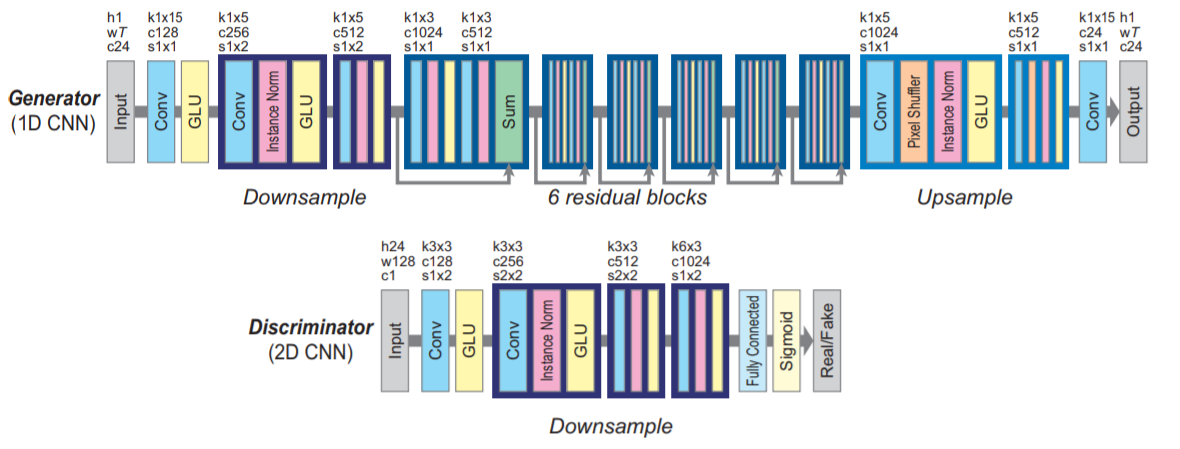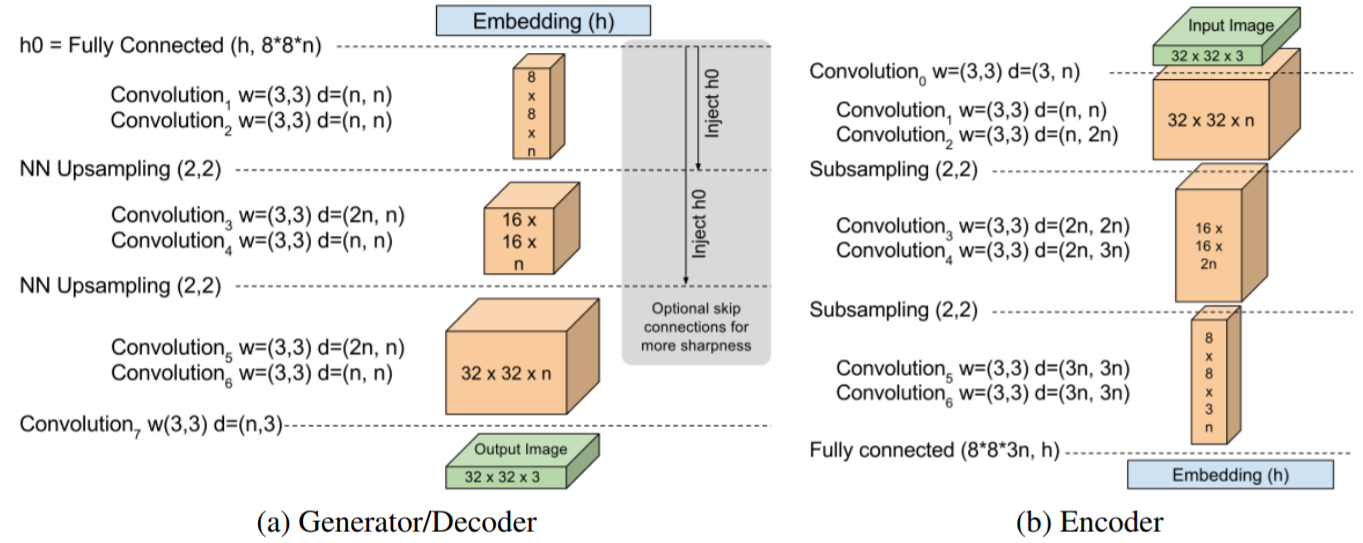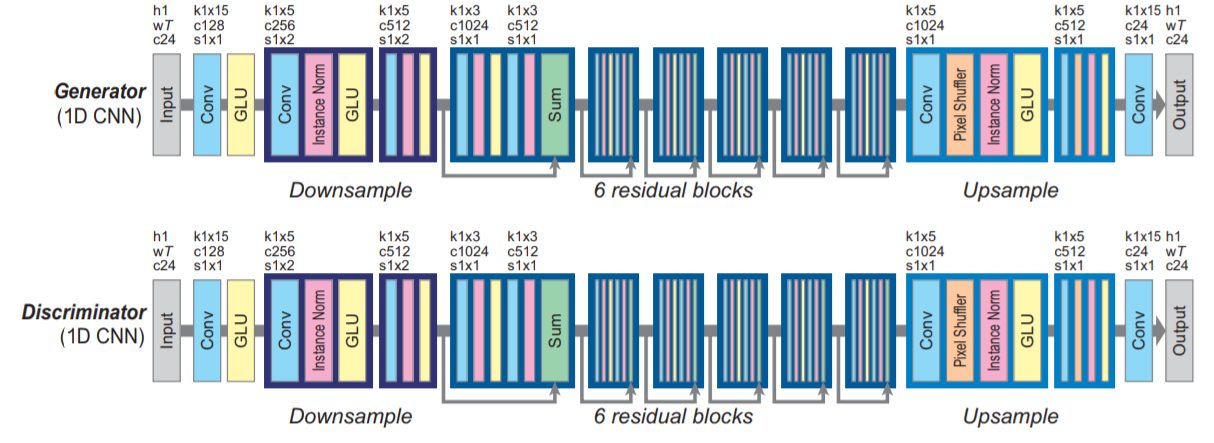-
My contribution on Team Project on Eliceio team4: vocal-style-transfer (https://github.com/eliceio/vocal-style-transfer)
-
I was in charge of transfering singing style by using separated vocal data(separated by pretrained Deep U net[2]) not by clean speech data. And I adapted BE-GAN[4] training skill to Cycle-GAN-VC[3] refer to Singing Style Transfer C-BEGAN [1].
-
First download songs from "Youtube" by using pytube library.(This might be illegal) For the vocal data I downloaded Park Hyo Shin and BolBBalGan Sachungi's songs. (about 15 songs each)
-
For the separation of Singing Voice & Accompaniment I used pretrained deep U-net model. [2]
-
Finally, use pydub library to remove silence on singing vocal data.
-
Vocal Representation
- Datas were downsampled to 16 kHz. For the separation normalized magnitude spectrogram were used and for the transfer 24 Mel-cepstral coefficients (MCEPs) were used.[2][3]
-
Since the singers we want to change don't sing same songs(Unpaired Data) I used Cycle-GAN for the transferring singing style.[1] Main model of Cycle-GAN is from "Cycle GAN Voice Converter".[3]
-
Cycle GAN Voice Converter: Gated CNN and Identyty-mapping loss was the main modification from the Original CycleGAN architecture.
- a. Gated CNN: Gated CNN paper
- Since RNN is computationally demanding due to the difficlty of parallel implementations, Cycle GAN VC used Gated CNN which not only allows parallelization over sequential data but also achieves state-ofthe-art in language modeling and speech modeling.
- In a gated CNN, gated linear units (GLUs) are used as an activation function where GLU is a is a data-driven activation function. (Orgiinal Cycle Gan used ReLU for generator and Leaky ReLU for Discriminator.)
- $ H_{l+1} = (H * W_{l} + b_{l}) \otimes \sigma(H_{l} * V_{l} + c_{l}) $
- short explanation about Gated CNN in korean
- b. Identity-Mapping Loss: Identity Loss paper
- To encourage linguistic-information preservation without relying on extra modules, Cycle GAN VC incorporate an identitymapping loss which encourages the generator to find the mapping that preserves composition between the input and output.
- The original study on CycleGAN showed the effectiveness of this loss for color preservation.
- Identity Loss short explanation on youtube
- 36min ~ 39min
- You could find more details about Cycle GAN Voice Converter on original paper[3]
- a. Gated CNN: Gated CNN paper
-
Modification on Cycle GAN Voice Converter:
-
I modified Discriminator Architecture, Adversarial Loss function and added hyper-parameters to adapt BEGAN training skill to Cycle GAN Voice Converter to stablize training process. [1][4]
-
Also, Due to the differeces between converting voices and converting singing style I expanded frames to 512. Which frames were 128 (about 0.5sec) from "Cycle Gan Voice Converter".
-
-
Original Architectures (Cycle GAN Voice Converter[3]) : code
-
BEGAN Architectures[4]: code
-
Modified Architectures(Cycle Consistency Boundary Equilibrium GAN): code
- Original Loss function (Cycle GAN Voice Converter[3]): code
- BEGAN Loss function [4]: code
- Modified Loss function (Cycle Consistency Boundary Equilibrium GAN): code
- Identity-Mapping Loss and Cycle Loss are same with Original Loss Function's Identity-Mapping Loss and Cycle Loss.
-
More powerful separation for vocal separation.
-
Hyper-parameter tuning
-
Embed more information such as lyrics and use Tacotron as a Generator.(maybe?) ex) Tacotron GAN "https://github.com/tmulc18/S2SCycleGAN"
[1] Cheng-Wei Wu, Jen-Yu Liu, Yi-Hsuan Yang, Jyh-Shing R. Jang. Singing Style Transfer Using Cycle-Consistent Boundary Equilibrium Generative Adversarial Networks. 2018
paper: https://arxiv.org/abs/1807.02254
[2] Andreas Jansson, Eric Humphrey, Nicola Montecchio, Rachel Bittner, Aparna Kumar, Tillman Weyde. SINGING VOICE SEPARATION WITH DEEP U-NET CONVOLUTIONAL NETWORKS. 2017.
paper: https://ismir2017.smcnus.org/wp-content/uploads/2017/10/171_Paper.pdf
code & pretrained model from: https://github.com/Xiao-Ming/UNet-VocalSeparation-Chainer
[3] Takuhiro Kaneko, Hirokazu Kameoka. Parallel-Data-Free Voice Conversion Using Cycle-Consistent Adversarial Networks. 2017.
paper:https://arxiv.org/abs/1711.11293
code: https://github.com/leimao/Voice_Converter_CycleGAN
[4] David Berthelot, Thomas Schumm, Luke Metz. BEGAN: Boundary Equilibrium Generative Adversarial Networks. 2017.
paper:https://arxiv.org/pdf/1703.10717.pdf
code: https://github.com/carpedm20/BEGAN-tensorflow






